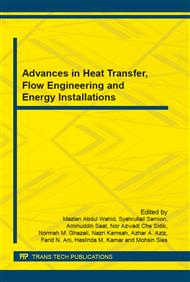p.314
p.319
p.326
p.330
p.335
p.341
p.346
p.351
p.356
Hydrodynamic Resistance Reduction of Multi-Purpose Amphibious Vehicle due to Air Bubble Effect
Abstract:
Multipurpose Amphibious Vehicles (MAV) and other blunt shaped floating vehicles encounter the problem of a large bow wave forming and hydrodynamic resistance at high speeds. This wave formation is accompanied by higher resistance and at a critical speed results in bow submerging or swamping. Three new shapes of hull bow design for the multipurpose amphibious vehicle were conducted at several speeds to investigate the hydrodynamic phenomena using Computational Fluid Dynamics (CFD, RANS code), which is applied by Ansys-CFX14.0 and Maxsurf. The vehicle’s hydrodynamic bow shapes were able to break up induced waves and avoid swamping. Comparative results with the vehicle fitted with U-shape, V-shape and Flat-shape of hull bow, showed that the U-shape of the hull bow has reduced the total resistance to 20.3% and 13.6% compared with the V-shape and flat shape respectively. Though, the U-shape of hull bow is capable to increase the amphibious operating life and speed of vehicle. Also it has ability to reduce the vehicle’s required power, fossil fuel consumption and wetted hull surface. On the other hand, the use of air cushions to support marine vehicles, heavy floating structures and in other operation is well known. The main problem in Multi-purpose Amphibious Vehicles (MAV) is the amount of power needed in order to overcome the hydrodynamic resistance acting on the hull which is included the frictional and pressure resistances. Therefore, more power is needed to move the MAV forward. In this respect, more fuel will be required to operate the amphibious vehicles. This problem could be effectively reduced by the introduction of the air cushion concept. With the air being drawn from top of craft to the cavity below the hull will produce some cushioning effect and also help to reduce skin friction drag. In this paper, air cushion effect will be studied in rigid surface cavity instead of using flexible skirts. This would avoid the problem of high maintenance due to replacement of damaged skirts. Finally, the MAV will be supported using air cavity and bubbles generated by an air pump (compressor and air pressure vessel) to pushes the hull of multi-purpose amphibious vehicle up and reduce the frictional resistance due to draft and wetted surface reduction and layer of air between hull surface and water. This research would be done via CFD (ANSYS-CFX 14.0) and analyzed the hydrodynamic resistance
Info:
Periodical:
Pages:
335-340
Citation:
Online since:
January 2016
Authors:
Price:
Сopyright:
© 2016 Trans Tech Publications Ltd. All Rights Reserved
Share:
Citation:


